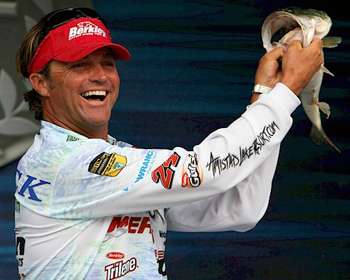
With heavy snowfalls through the winter, or extended rain across southern states, you can expect the annual spring ritual of sight fishing to be a challenge.
Even under normal precipitation, anglers in many locales have trouble understanding the allure of sight fishing, since their waters are too muddy for them to see under the surface.
Elite Series pro Byron Velvick, long noted as one of the best sight fishermen in the game today, explains that while "sight fishing" isn't the right term to use in muddy water, it's still very possible to fish for bedding bass. "Whenever you're bed fishing in muddy water, you're really just target fishing," he explains.
"You're looking for the stem of a tule or a perfect little area where a bass should be bedding." As he explains, bed fishing in muddy water has much more to do with visualizing where a bass should be on a bed — whether it's a small pocket in a cove or an isolated piece of wood — than it does with your ability to see them. "What happens is that you begin to pick out these areas along a flat where bass should be bedding," he says.
"I like to start by dead sticking a trick worm. Suddenly, you'll notice that your line just starts to swim off. After that happens a couple of times, you can really start to pinpoint the types of cover where the beds are located." Velvick likens this type of blind bed fishing to being almost psychic.
"In the area that you're fishing, you begin to imagine where a bed should be, to the point where you can almost see the fish sitting there," he explains. "The whole trick is in fishing slow enough through those areas so that a bass protecting a bed will react to the bait.
That's the 'psychic' part of the deal — just being able to really visualize where the beds are." The problem most anglers experience, as Velvick points out, is the tendency to fish through an area without giving it much thought. "If you're fishing in an area where bass should be set up to spawn, odds are, the fish are there.
You just have to slow down," coaches Velvick. "As an angler, your job is to get them to bite. When you can't see a bedding bass, it's hard to convince yourself that there's a bass in the area. By really slowing down, you can start to isolate where bedding fish are set up." While it's important to slow down in muddy water, Velvick cautions against spending too much time in a given area without a bite. "It doesn't sound like a long time, but I won't spend more than a minute focused on one particular cast without moving my bait," he says.
"If you're in the vicinity of a bed you'll know it because a bass guarding a nest will pick the bait up and move it out of the area," he says. "You have to remember than in low-visibility conditions, the bass aren't as likely to spook and are often more aggressive than bedding fish in clear water. You can use that to your advantage."
(Provided by Z3 Media)




